The blog of cooking-ez.com
What happens to the bread when you make it?
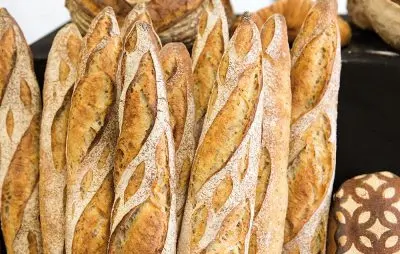
This bread that we eat every day, and that our baker makes for us, what happens during its manufacture so that it becomes bread?
I will try to answer this question, and to summarize the complex alchemy that takes place.
I will try to answer this question, and to summarize the complex alchemy that takes place.
8,758 19 4.9
Last modified on: May 28th 2021
What happens to the bread when you make it?
What's in bread?
Let's start with the basics, for classic bread, which is improperly called "white bread", baguette for example, it's extremely simple there can/should only be 4 things: flour, water, a bit of salt, and a dollop of yeast or leaven, or sometimes both. Full stop!All the rest: additives, improvers, flavour enhancers, correctors, etc. are chemicals, "crutches" as the bakers say, additions that are only there for bad bakers or the food industry, or both, and that have no place in a good quality bread.
I'll detail a bit: Flour contains mainly starch (a sugar), a lot, and gluten (a protein), quite a bit.
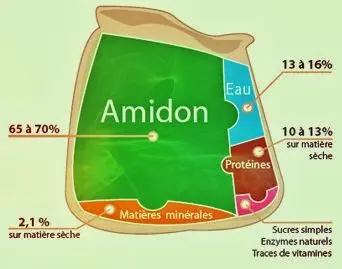
What happens?
As soon as the baker mixes the water, flour, and yeast/leaven, it starts, a complex mechanism gets underway, which will result in the little daily miracle of crusty bread.1) On the first hand, the yeast or sourdough, microscopic fungi, will attack the starch, and produce carbon dioxide, CO2 and alcohol.
This is the so-called alcoholic fermentation, the same as in wine and beer, but don't worry about the alcohol, it will disappear when cooked (at 250°C).
2) On the other hand, kneading the future dough acts mechanically on its gluten, little by little this protein structures itself into a network, and thus forms a rather elastic dough, which is at the same time capable of retaining the CO2 produced by the fermentation.
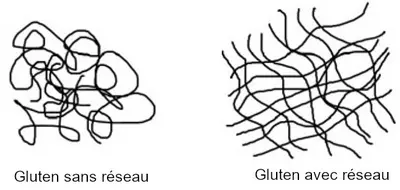
It is this CO2, trapped by the network, which cannot escape and which forms bubbles in the dough, bubbles which will become cells in the bread once it is baked.
The dough is said to be structured or "networked" when the kneading is finished, a moment not so easy to determine.
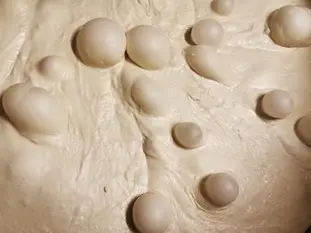
You see it's a duo of action, one without the other, would not give good bread :
- No fermentation => no CO2 => flat, hard dough => inedible bread.
- No gluten network => the CO2 from the fermentation escapes because it is not retained => flat and hard dough => bread that is also inedible.
The dough, well kneaded and leavened, is put in the oven, at around 250°C, the alcohol is quickly eliminated, the cooking at the beginning accelerates a little the production of CO2 from the yeast, the dough still rises, then the cooking really starts and freezes everything.
The bubbles are cooked, the crumb is aerated, and the crust turns golden under the action of the famous Maillard reactions.
And in the end, a crisp, golden bread with a delicious smell spreads all around the oven.
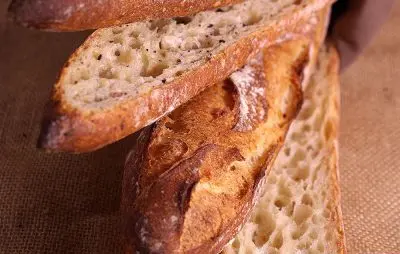
Is that all?
Well in broad strokes yes, overall it's all there, but it's the whole difficulty of the baking trade to manage these 2 aspects of fermentation and kneading, then baking, to make you, regularly, a good loaf.Some points of detail
- The gluten network, this is what makes a gluten-free bread very difficult to make, it's not really bread some would say, it's impossible others would say, because you have to manage to imitate a network to trap the CO2, either by adding a binder (bof!) or by moulding the dough, a bit like a cake, or both. This is why gluten-free breads look more like cakes than breads.It should also be noted that the gluten of today is very different from that of just 50 years ago, the original sin coming from the 70's when we started to make bread, faster and faster, whiter and whiter and more and more bland, and therefore increased the gluten content of the flours, and also selected short-legged wheats, richer and richer in an increasingly strong gluten. This is undoubtedly the main cause of the many gluten-related problems of our time, a gluten that is much less digestible than before.
One last piece of information about gluten, sourdough breads, apart from their extraordinary taste and nutritional advantages, and partly thanks to their long, even very long, fermentation times, these sourdough breads therefore favour the digestibility of gluten.
In other words, if you have problems with gluten in your daily diet, try (quality) sourdough bread.
- The fermentation-kneading duo does not only apply to bread, but also to viennoiserie (brioche, croissants,...) to pizzas, and in fact to all the so-called "fermented" doughs precisely, it's the borderline between baking and pastry-making.
Respectus panis
If you don't knead the dough, no gluten network you will have understood, but there is another alternative which is time: If you only mix the ingredients, 1 or 2 minutes maximum, and leave the dough for a very long time (18 to 20 hours) at around 16°C with very little yeast/leaven and less salt, the network will still build up by itself, very slowly, but surely. "Time is on my side", if you have the Stones ref...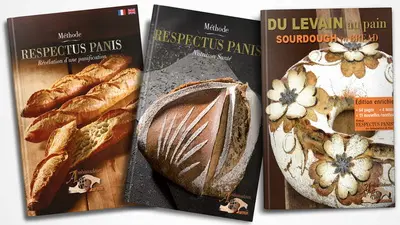
In summary: Bread is a duo of actions, kneading (1) to form the gluten network, which will trap the CO2 from fermentation (2).
Lasts posts
Wipe meats and fish before cooking
When you want to cook meat or fish, there's a very simple yet very important step to take before you even start: It's to dry, or wipe, each side of the meat or fish, sometimes called "dabbing" or "sponging". But why? And how? Let me explain.1,5065 April 14th 2024
Toss the salad
When you've finished preparing a salad, green or otherwise, it's usually time to add the dressing and toss. It's often said to "toss the salad", which means to season and mix. Is it easy? Not so easy...2,8485 March 8th 2024
Half milk, half cream
In a multitude of recipes, savoury or sweet, milk is used as the main ingredient, or at least as the main liquid ingredient. Milk is used instead of water, for example, because milk contains a proportion of fat, which adds roundness and softness to the recipe. This mellowness is very pleasant on...2,688 February 27th 2024
Cutting soft cheeses
As you may have already noticed, when you have to use a "soft" cheese in a recipe - their exact name is "soft cheese" - such as Camembert, Munster or Mont d'or, it's not easy to make anything other than thick slices.2,8075 February 20th 2024
It's spinning too fast!
When you need to grate or slice vegetables, you generally use an electric machine that does all the work: a food processor, a mixer with a "slicer" extension or similar. Are these machines really suitable? Generally speaking, yes of course, but there's one criterion that often poses a problem,...5,7725 November 12th 2023
Other pages you may also like
Fruits which can ruin your jelly
There are many ways of making a fruit mousse, but one of the simplest is to prepare a fruit jelly (basically a fresh fruit coulis with gelatine) and then mix this jelly before it sets completely with whipped cream. The result is perfect for filling a charlotte, for example. But do beware;...68K4.0 March 6th 2013
What is the difference between bakery and patisserie?
This is a question that you may well have asked yourself and which I will attempt to answer. In France the two trades of "boulangerie" (bakery) and "pâtisserie" (patisserie and confectionery) have always been quite distinct, but where exactly do the boundaries lie? .119K 14.1 February 7th 2017
A few tips for effective kneading at home
When you have to knead dough for bread or some other recipe, you may well use a food processor or the type of machine known as a stand mixer. The best-known brands are Kenwood and KitchenAid. They are useful tools, but here are a few tips to help you get the best out of them.266K 23.7 June 23th 2021
The right weight of pastry for a pie
Let's try to solve a thorny problem: How much dough will I need when I make my next pie? You're planning to make a pie, you're going to use your favourite mould or circle, but how much pastry will you need to fill it completely with a well spread pastry, without being too thin, or on the contrary...58K4.3 March 20th 2020
Kitchen ovens
You certainly have one in your kitchen, an oven, the essential tool for all kinds of cooking, whether in the kitchen of course, but also in pastry, bakery, pizza, and many others. Here is some information on its structure and operation.22K4.4 May 16th 2020
Follow this page
If you are interested in this page, you can "follow" it, by entering your email address here. You will then receive a notification immediately each time the page is modified or a new comment is added. Please note that you will need to confirm this following.
Note: We'll never share your e-mail address with anyone else.
Alternatively: you can subscribe to the mailing list of cooling-ez.com , you will receive a e-mail for each new recipe published on the site.









